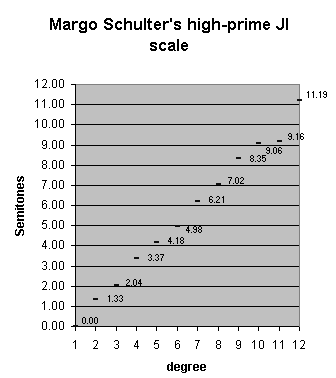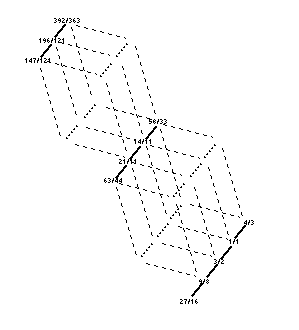Margo Schulter has a well-known fondness for medieval music and Pythagorean tunings, as well as for some exotic ETs (such as 17-tET), which she uses primarily to compose what she calls 'xeno-Gothic' music.
Recently, however, in Tuning List message 12989, she proposed what she calls a multi-prime neo-Gothic JI scale, consisting of 12 notes so that it can be easily mapped to a regular keyboard.
In another post,
message
13027, she corrected an error in her keyboard mapping diagram,
giving the scale as follows (I have modified her diagram
somewhat, and simplified it by changing her
cents-values into
Semitones):
392/363 147/121 4/3 196/121 56/33
1.33 3.37 4.98 8.35 9.16
f# g# bb c#' d+1'
/ \ / \ / \ / \ / \
1.33 0.71 1.33 0.81 0.81 1.23 1.33 0.71 0.10 2.04
/ \ / \ / \ / \ / \
f g a b c' d' e' f'
1/1 9/8 14/11 63/44 3/2 27/16 21/11 2/1
0 2.04 4.18 6.21 7.02 9.06 11.19 12.00
\/ \/ \/ \/ \/ \/ \/
9:8 112:99 9:8 22:21 9:8 112:99 22:21
2.04 2.14 2.04 0.81 2.04 2.14 0.81
(Margo pointed out that her earlier error gave the wrong cents-value for 21/11, and proceeded to give the correct value of 1119.463 cents in her text, but inadvertently made a typo in her diagram again and gave it as 1119.643 cents.
Also, Margo says this scale has 'two versions of D, one mapped to the usual "D" key of a 12-note keyboard and the other to the "Eb" key. These two keys provide pure fifths for G and A respectively...'. But this is not correct: the note d+1' (56/33) is a 4:3 'perfect 4th' above "a" (14/11), not a '5th'. The note e' (21/11) is a 'perfect 5th' above "a" (14/11).)
Here is a pitch-height graph showing the Semitone values of the notes in the scale:

Margo noted some important features of the structure of this tuning as follows:
The basic idea of the tuning is to combine pure 3:2 fifths and 14:11 major thirds or ditones, the latter used as unstable but "relatively blending" intervals in neo-Gothic styles, much like the usual Pythagorean 81:64 of Gothic polyphony.. . .
Here a crude lattice diagram, with an enthusiastic and appreciative invitation for more refined and sophisticated versions to the various exponents of this craft on the Tuning List, may be helpful.
Notes connected in horizontal rows form chains of pure 3:2 fifths, while diagonally connected major thirds (e.g. F0-A+1, E+1-G#+2) form pure 14:11 ratios, also expressible as the classic mediant between 5:4 and 9:7, or (5+9):(4+7).
F#+2 - C#+2 - G#+2 / / / / / / D+1 - A+1 - E+1 - B+1 / / / / / / / / Bb0 - F0 - C0 - G0 - D0
She asked me both on the List and again in a private email if I would make a lattice diagram of this scale, according to my lattice formula. Here it is:

The lattice diagram clearly displays the features discussed by Margo, on which I elaborate further:
- The prime-factors are 2 (not shown on this '8ve'-equivalent diagram), 3, 7, and 11. The prime-factor 5, which was especially important during a long period after that of Margo's main interest, is conspicuously absent. This feature also makes her scale a relative to many of those conceived by La Monte Young, who uses 3 and 7 a lot, and often many higher primes, but never 5.
- The scale is clearly divided into 3 basic parts, all of which are chains of 3/2s ('perfect 5ths'). This is something which betrays Margo's primary interest in Pythagorean tunings. On the lattice, the pitches in each chain are connected by solid lines.
- There are no direct connections between the chains of 3/2s along the 7 or 11 axes, both of these factors always being used together (i.e., the ratio 7/11 or 14/11) to connect pitches in two different chains. I have therefore used dashed lines to connect the chains of 3/2s, leaving blank spaces for the missing direct connections to 71 and 11-1.
An interesting feature of Margo's scale , which she discusses in her Tuning List post, is that it uses 14/11 as exactly the kind of 'cross-exponent lattice connection' that I explored in detail in my Tuning List post message 2179 Sat Apr 3, 1999 00:14am. (Also see the small correction message 2190 Mon Apr 5, 1999 3:43am.) This is reflected very well in her own 'crude lattice diagram' above.
Here is a version of the lattice resembling my lattice formula
but slightly different due to ASCII limitations.
The lattice-points can be clicked to play a MIDI-file
of that pitch:
392:363 --------
F#+2 /\
/ \ / \
196:121 -------- \
C#+2 \ /\ \
/ \ \ / \ \
147:121 -------- \ \
G#+2 \ \\ \ \
\ \ \-----\-- 56:33 ---------
\ \ / \ \ D+1 /\
\ \ / \ \ / \ / \
\ --------- 14:11 --------- \
\ / \ A+1 \ /\ \
\ / \ / \ \ / \ \
--------- 21:11 --------- \ \
E+1 \ /\ \ \
/ \ \ / \\ ----\--- 4:3
63:44 -------- / \ \ Bb0
B+2 \ \\ / \ \ /
\ \ \-----\--- 1:1
\ \ / \ \ /F0
\ \ / \ \ /
\ ---------- 3:2
\ / \ /C0
\ / \ /
---------- 9:8
/G0
/
27:16
D0